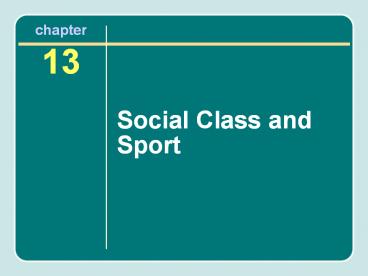Social Class and Sport - PowerPoint PPT Presentation
Title:
Social Class and Sport
Description:
chapter 13 Social Class and Sport Chapter Outline Social Classes Social Class and Sport Activity Control of Sport Class Mobility in Sport Summary Economic Class ... – PowerPoint PPT presentation
Number of Views:269
Avg rating:3.0/5.0
Title: Social Class and Sport
1
chapter 13
- Social Class and Sport
2
Chapter Outline
- Social Classes
- Social Class and Sport Activity
- Control of Sport
- Class Mobility in Sport
- Summary
3
Economic Class Divisions
- Social class The categories of people who share
similar positions in society based on their
economic level, education, occupation, and social
interaction. - Social stratification The assignment of class
based on inequalities in society such as power,
prestige, and wealth.
4
Key Point
- Individual opportunities in life are affected by
class status.
5
Developing Capital
- Economic capital The financial resources that one
has or controls. These resources affect how we
see the world and opportunities available to us. - Social capital Resources available to a person
based on memberships, relationships, and both
social and business networks. Social capital is
affected by family and friends. - Cultural capital The skills and abilities we have
based on our education and life experiences.
6
Key Point
- Capital affects the sports we watch, play, and
succeed in.
7
- How does social class affect sport involvement,
sport opportunities, and leadership or
decision-making opportunities in sport?
8
Social Class
- Social class status affects sport opportunities.
- Upper class
- Wealthy (with disposable income)
- Exclusive memberships, used to build social
capital - Can afford exceptional coaching and sport
experiences - Have the highest rates of sport participation
- Play exclusive sports such as golf, tennis, polo
- More likely to use health and fitness equipment
(continued)
9
Social Class (continued)
- Upper-middle class
- Professionals such as lawyers, managers,
physicians - Many sport experiences and opportunities such as
gymnastics, swimming, and archery - Middle class
- Make careful decisions about expenses
- Many sport opportunities in community
- Lower class
- Low annual income (18,810 U.S.)
- Play team sports available and subsidized in the
community - Play strength, speed, and daring sports such as
boxing wrestling, racing
10
Access and Barriers to Sport
- Cost of high-performance training
- Requires economic, social, and cultural capital
- Top coaching and training can run as high as
75,000 U.S. each year in some individual sports - Must pay for coaching, facilities, physical
training, travel, equipment - Team sports
- Often run and subsidized by community
- Allows most kids to play
- Coaching is much more affordable
(continued)
11
Access and Barriers to Sport (continued)
- High school sports
- Affluent schools win more championships
- Afford better facilities, equipment, and coaches
- Participants start sports earlier and receive
more training - Affluent schools win more female championships
than male championships - Community leagues
- Serve more children at a modest expense
- Provide training even in traditionally
upper-class sports
12
Who Controls Sport?
- Local communities Power is in the hands of
administrators and boards of directors (parents,
politicians). - National level Power is in the hands of the
people who control the money for the
organization. - Often from upper class or upper-middle class
- Media moguls (Rupert Murdoch), league
commissioners, and superstar athletes - Often White males
13
Key Point
- People with power in sport have the ability to
promote or prevent change in the game.
14
Social Mobility Through Sport
- Educational opportunities
- Need to stay academically eligible to play
- Possibility for athletic scholarships (sport
helps build social and cultural capital) - College athletes may have more opportunities than
nonathletes - Leaders in business often attribute success to
lessons learned through sport - Is class mobility through sport possible?
- Unrealistic expectation
- Only 0.2 of high school athletes play
professionally - Best opportunity is to advance is through
education
15
Summary
- Opportunities in life are affected by social
class. - Social class affects the sports that we play.
- Money allows access to elite competition in many
sports. - Power in sport lies with those who have the
ability to make changes. Often these people are
White males. - Sport can provide some opportunities for social
mobility, but it also provides some false hope.
16
On Deck
- Questions and comments
- Assignments and readings
- Next chapter Special Populations and Sport
- People with disabilities
- Aging adults































